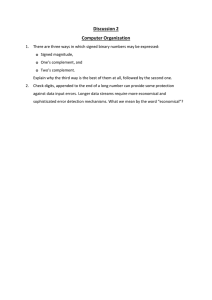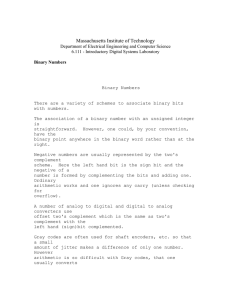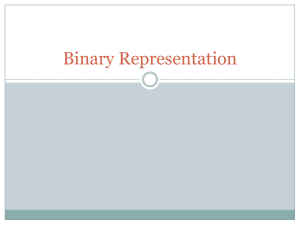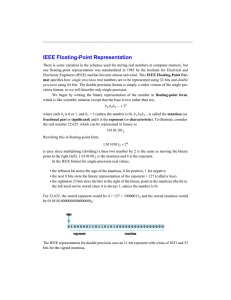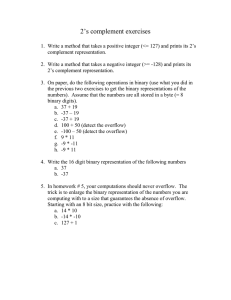عرض محاضرات الفصل الثاني
advertisement
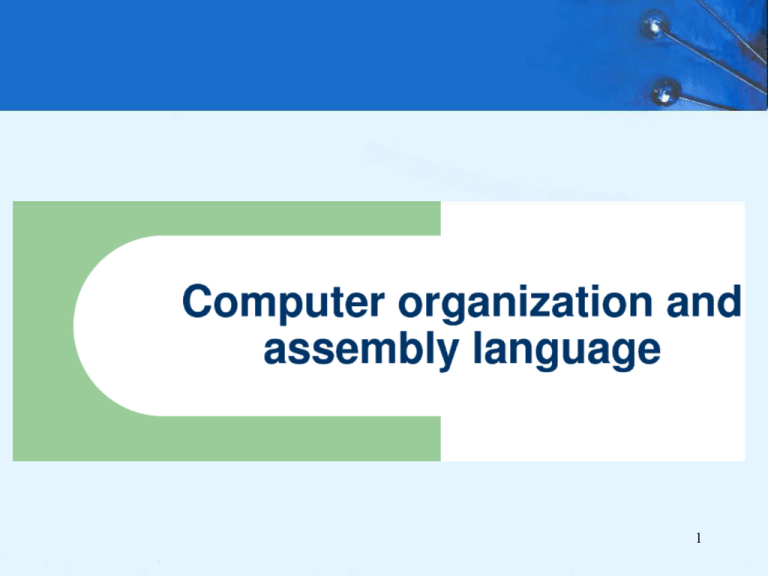
1 CHAPTER 2 Data Representation in Computer Systems 2 Chapter 2 Objectives • Understand the fundamentals of numerical data representation and manipulation in digital computers. • Master the skill of converting between various radix systems. • Understand how errors can occur in computations because of overflow and truncation. 3 Chapter 2 Objectives • Understand the fundamental concepts of floatingpoint representation. • Gain familiarity with the most popular character codes. • Understand the concepts of error detecting and correcting codes. 4 2.1 Introduction • A bit is the most basic unit of information in a computer. – It is a state of “on” or “off” in a digital circuit. – Sometimes these states are “high” or “low” voltage instead of “on” or “off..” • A byte is a group of eight bits. – A byte is the smallest possible addressable unit of computer storage. – The term, “addressable,” means that a particular byte can be retrieved according to its location in memory. 5 2.1 Introduction • A word is a contiguous group of bytes. – Words can be any number of bits or bytes. – Word sizes of 16, 32, or 64 bits are most common. – In a word-addressable system, a word is the smallest addressable unit of storage. • A group of four bits is called a nibble. – Bytes, therefore, consist of two nibbles: a “high-order nibble,” and a “low-order” nibble. 6 2.2 Positional Numbering Systems • Bytes store numbers using the position of each bit to represent a power of 2. – The binary system is also called the base-2 system. – Our decimal system is the base-10 system. It uses powers of 10 for each position in a number. – Any integer quantity can be represented exactly using any base (or radix). 7 2.2 Positional Numbering Systems • The decimal number 947 in powers of 10 is: 9 10 2 + 4 10 1 + 7 10 0 • The decimal number 5836.47 in powers of 10 is: 5 10 3 + 8 10 2 + 3 10 1 + 6 10 0 + 4 10 -1 + 7 10 -2 8 2.2 Positional Numbering Systems • The binary number 11001 in powers of 2 is: 1 24+ 1 23 + 0 22 + 0 21 + 1 20 = 16 + 8 + 0 + 0 + 1 = 25 • When the radix of a number is something other than 10, the base is denoted by a subscript. – Sometimes, the subscript 10 is added for emphasis: 110012 = 2510 9 2.3 Binary to Hex Conversions • The binary numbering system is the most important radix system for digital computers. • However, it is difficult to read long strings of binary numbers-- and even a modestly-sized decimal number becomes a very long binary number. – For example: 110101000110112 = 1359510 • For compactness and ease of reading, binary values are usually expressed using the hexadecimal, or base-16, numbering system. 10 2.3 Binary to Hex Conversions • The hexadecimal numbering system uses the numerals 0 through 9 and the letters A through F. – The decimal number 12 is C16. – The decimal number 26 is 1A16. • It is easy to convert between base 16 and base 2, because 16 = 24. • Thus, to convert from binary to hexadecimal, all we need to do is group the binary digits into groups of four. 11 2.3 Binary to Hex Conversions • The binary number 110101000110112 (= 1359510) in hexadecimal is: • Octal (base 8) values are derived from binary by using groups of three bits (8 = 23): 12 2.4 Signed Integer Representation • The conversions we have so far presented have involved only positive numbers. • To represent negative values, computer systems allocate the high-order bit to indicate the sign of a value. – The high-order bit is the leftmost bit in a byte. It is also called the most significant bit. • The remaining bits contain the value of the number. 13 2.4 Signed Integer Representation • There are three ways in which signed binary numbers may be expressed: – Signed magnitude, – One’s complement, and – Two’s complement. • In an 8-bit word, signed magnitude representation places the absolute value of the number in the 7 bits to the right of the sign bit. 14 2.4 Signed Integer Representation • For example, in 8-bit signed magnitude, positive 3 is: 00000011 negative 3 is: 10000011 • Computers perform arithmetic operations on signed magnitude numbers in much the same way as humans carry out pencil and paper arithmetic. – Humans often ignore the signs of the operands while performing a calculation, applying the appropriate sign after the calculation is complete. 15 2.4 Signed Integer Representation • Binary addition is as easy as it gets. You need to know only four rules: 0 + 0 = 0 0 + 1 = 1 1 + 0 = 1 1 + 1 = 10 • The simplicity of this system makes it possible for digital circuits to carry out arithmetic operations. 16 2.4 Signed Integer Representation • Example 1: – Using signed magnitude binary arithmetic, find the sum of 75 and 46. • First, convert 75 and 46 to binary, and arrange as a sum, but separate the (positive) sign bits from the magnitude bits. 17 2.4 Signed Integer Representation • Example 1: – Using signed magnitude binary arithmetic, find the sum of 75 and 46. • Just as in decimal arithmetic, we find the sum starting with the rightmost bit and work left. 18 2.4 Signed Integer Representation • Example 1: – Using signed magnitude binary arithmetic, find the sum of 75 and 46. • In the second bit, we have a carry, so we note it above the third bit. 19 2.4 Signed Integer Representation • Example 1: – Using signed magnitude binary arithmetic, find the sum of 75 and 46. • The third and fourth bits also give us carries. 20 2.4 Signed Integer Representation • Example 1: – Using signed magnitude binary arithmetic, find the sum of 75 and 46. • Once we have worked our way through all eight bits, we are done. 21 2.4 Signed Integer Representation • Example: – Using signed magnitude binary arithmetic, find the sum of 107 and 46. • We see that the carry from the seventh bit overflows and is discarded, giving us the erroneous result: 107 + 46 = 25. 22 2.4 Signed Integer Representation • The signs in signed magnitude representation work just like the signs in pencil and paper arithmetic. – Example: Using signed magnitude binary arithmetic, find the sum of - 46 and - 25. • Because the signs are the same, all we do is add the numbers and supply the negative sign when we are done. 23 2.4 Signed Integer Representation • Mixed sign addition (or subtraction) is done the same way. – Example: Using signed magnitude binary arithmetic, find the sum of 46 and - 25. • The sign of the result gets the sign of the number that is larger. – Note the “borrows” from the second and sixth bits. 24 2.4 Signed Integer Representation • Signed magnitude representation is easy for people to understand, but it requires complicated computer hardware. • Another disadvantage of signed magnitude is that it allows two different representations for zero: positive zero and negative zero. • For these reasons computer systems employ complement systems for numeric value representation. 25 2.4 Signed Integer Representation • In complement systems, negative values are represented by some difference between a number and its base. • In diminished radix complement systems, a negative value is given by the difference between the absolute value of a number and one less than its base. • In the binary system, this gives us one’s complement. 26 2.4 Signed Integer Representation • For example, in 8-bit one’s complement, positive 3 is: 00000011 negative 3 is: 11111100 • In one’s complement, as with signed magnitude, negative values are indicated by a 1 in the high order bit. • Complement systems are useful because they eliminate the need for subtraction. 27 2.4 Signed Integer Representation • With one’s complement addition, the carry bit is “carried around” and added to the sum. – Example: Using one’s complement binary arithmetic, find the sum of 48 and - 19 We note that 19 in one’s complement is 00010011, so -19 in one’s complement is: 11101100. 28 2.4 Signed Integer Representation • Although the “end carry around” adds some complexity, one’s complement is simpler to implement than signed magnitude. • But it still has the disadvantage of having two different representations for zero: positive zero and negative zero. • Two’s complement solves this problem. • Two’s complement is the radix complement of the binary numbering system. 29 2.4 Signed Integer Representation • To express a value in two’s complement: – If the number is positive, just convert it to binary and you’re done. – If the number is negative, find the one’s complement of the number and then add 1. • Example: – In 8-bit one’s complement, positive 3 is: 00000011 – Negative 3 in one’s complement is: 11111100 – Adding 1 gives us -3 in two’s complement form: 11111101. 30 2.4 Signed Integer Representation • With two’s complement arithmetic, all we do is add our two binary numbers. Just discard any carries emitting from the high order bit. – Example: Using two’s complement binary arithmetic, find the sum of 48 and - 19. We note that 19 in one’s complement is: 00010011, so -19 in one’s complement is: 11101100, and -19 in two’s complement is: 11101101. 31 2.4 Signed Integer Representation • When we use any finite number of bits to represent a number, we always run the risk of the result of our calculations becoming too large to be stored in the computer. • While we can’t always prevent overflow, we can always detect overflow. • In complement arithmetic, an overflow condition is easy to detect. 32 2.4 Signed Integer Representation • Example: – Using two’s complement binary arithmetic, find the sum of 107 and 46. • We see that the nonzero carry from the seventh bit overflows into the sign bit, giving us the erroneous result: 107 + 46 = -103. Rule for detecting signed two’s complement overflow: When the “carry in” and the “carry out” of the sign bit differ, overflow has occurred. 33 2.4 Signed Integer Representation • Overflow and carry are tricky ideas. • Signed number overflow means nothing in the context of unsigned numbers, which set a carry flag instead of an overflow flag. • If a carry out of the leftmost bit occurs with an unsigned number, overflow has occurred. • Carry and overflow occur independently of each other. The table on the next slide summarizes these ideas. 34 2.4 Signed Integer Representation 35 2.5 Floating-Point Representation • The signed magnitude, one’s complement, and two’s complement representation that we have just presented deal with integer values only. • Without modification, these formats are not useful in scientific or business applications that deal with real number values. • Floating-point representation solves this problem. 36 2.5 Floating-Point Representation • If we are clever programmers, we can perform floating-point calculations using any integer format. • This is called floating-point emulation, because floating point values aren’t stored as such, we just create programs that make it seem as if floatingpoint values are being used. • Most of today’s computers are equipped with specialized hardware that performs floating-point arithmetic with no special programming required. 37 2.5 Floating-Point Representation • Floating-point numbers allow an arbitrary number of decimal places to the right of the decimal point. – For example: 0.5 0.25 = 0.125 • They are often expressed in scientific notation. – For example: 0.125 = 1.25 10-1 5,000,000 = 5.0 106 38 2.5 Floating-Point Representation • Computers use a form of scientific notation for floating-point representation • Numbers written in scientific notation have three components: 39 2.5 Floating-Point Representation • Computer representation of a floating-point number consists of three fixed-size fields: • This is the standard arrangement of these fields. 40 2.5 Floating-Point Representation • The one-bit sign field is the sign of the stored value. • The size of the exponent field, determines the range of values that can be represented. • The size of the significand (mantissa) determines the precision of the representation. 41 2.5 Floating-Point Representation • The IEEE-754 single precision floating point standard uses an 8-bit exponent and a 23-bit significand. • The IEEE-754 double precision standard uses an 11bit exponent and a 52-bit significand. For illustrative purposes, we will use a 14-bit model with a 5-bit exponent and an 8-bit significand. 42 2.5 Floating-Point Representation • The significand of a floating-point number is always preceded by an implied binary point. • Thus, the significand always contains a fractional binary value. • The exponent indicates the power of 2 to which the significand is raised. 43 2.5 Floating-Point Representation • Example: – Express 3210 in the simplified 14-bit floating-point model. • We know that 32 is 25. So in (binary) scientific notation 32 = 1.0 x 25 = 0.1 x 26. • Using this information, we put 110 (= 610) in the exponent field and 1 in the significand as shown. 44 2.5 Floating-Point Representation • The illustrations shown at the right are all equivalent representations for 32 using our simplified model. • Not only do these synonymous representations waste space, but they can also cause confusion. 45 2.5 Floating-Point Representation • Another problem with our system is that we have made no allowances for negative exponents. We have no way to express 0.5 (=2 -1)! (Notice that there is no sign in the exponent field!) All of these problems can be fixed with no changes to our basic model. 46 2.5 Floating-Point Representation • To resolve the problem of synonymous forms, we will establish a rule that the first digit of the significand must be 1. This results in a unique pattern for each floating-point number. – In the IEEE-754 standard, this 1 is implied meaning that a 1 is assumed after the binary point. – By using an implied 1, we increase the precision of the representation by a power of two. (Why?) In our simple instructional model, we will use no implied bits. 47 2.5 Floating-Point Representation • To provide for negative exponents, we will use a biased exponent. • A bias is a number that is approximately midway in the range of values expressible by the exponent. We subtract the bias from the value in the exponent to determine its true value. – In our case, we have a 5-bit exponent. We will use 16 for our bias. This is called excess-16 representation. • In our model, exponent values less than 16 are negative, representing fractional numbers. 48 2.5 Floating-Point Representation • Example: – Express 3210 in the revised 14-bit floating-point model. • We know that 32 = 1.0 x 25 = 0.1 x 26. • To use our excess 16 biased exponent, we add 16 to 6, giving 2210 (=101102). • Graphically: 49 2.5 Floating-Point Representation • Example: – Express 0.062510 in the revised 14-bit floating-point model. • We know that 0.0625 is 2-4. So in (binary) scientific notation 0.0625 = 1.0 x 2-4 = 0.1 x 2 -3. • To use our excess 16 biased exponent, we add 16 to -3, giving 1310 (=011012). 50 2.5 Floating-Point Representation • Example: – Express -26.62510 in the revised 14-bit floating-point model. • We find 26.62510 = 11010.1012. Normalizing, we have: 26.62510 = 0.11010101 x 2 5. • To use our excess 16 biased exponent, we add 16 to 5, giving 2110 (=101012). We also need a 1 in the sign bit. 51 2.5 Floating-Point Representation • The IEEE-754 single precision floating point standard uses bias of 127 over its 8-bit exponent. – An exponent of 255 indicates a special value. • If the significand is zero, the value is infinity. • If the significand is nonzero, the value is NaN, “not a number,” often used to flag an error condition. • The double precision standard has a bias of 1023 over its 11-bit exponent. – The “special” exponent value for a double precision number is 2047, instead of the 255 used by the single precision standard. 52 2.5 Floating-Point Representation • Both the 14-bit model that we have presented and the IEEE-754 floating point standard allow two representations for zero. – Zero is indicated by all zeros in the exponent and the significand, but the sign bit can be either 0 or 1. • This is why programmers should avoid testing a floating-point value for equality to zero. – Negative zero does not equal positive zero. 53 2.5 Floating-Point Representation • Floating-point addition and subtraction are done using methods analogous to how we perform calculations using pencil and paper. • The first thing that we do is express both operands in the same exponential power, then add the numbers, preserving the exponent in the sum. • If the exponent requires adjustment, we do so at the end of the calculation. 54 2.5 Floating-Point Representation • Example: – Find the sum of 1210 and 1.2510 using the 14-bit floatingpoint model. • We find 1210 = 0.1100 x 2 4. And 1.2510 = 0.101 x 2 1 = 0.000101 x 2 4. • Thus, our sum is 0.110101 x 2 4. 55 2.5 Floating-Point Representation • Floating-point multiplication is also carried out in a manner akin to how we perform multiplication using pencil and paper. • We multiply the two operands and add their exponents. • If the exponent requires adjustment, we do so at the end of the calculation. 56 2.5 Floating-Point Representation • Example: – Find the product of 1210 and 1.2510 using the 14-bit floating-point model. • We find 1210 = 0.1100 x 2 4. And 1.2510 = 0.101 x 2 1. • Thus, our product is 0.0111100 x 2 5 = 0.1111 x 2 4. • The normalized product requires an exponent of 2210 = 101102. 57 2.5 Floating-Point Representation • No matter how many bits we use in a floatingpoint representation, our model must be finite. • The real number system is, of course, infinite, so our models can give nothing more than an approximation of a real value. • At some point, every model breaks down, introducing errors into our calculations. • By using a greater number of bits in our model, we can reduce these errors, but we can never totally eliminate them. 58 2.5 Floating-Point Representation • Our job becomes one of reducing error, or at least being aware of the possible magnitude of error in our calculations. • We must also be aware that errors can compound through repetitive arithmetic operations. • For example, our 14-bit model cannot exactly represent the decimal value 128.5. In binary, it is 9 bits wide: 10000000.12 = 128.510 59 2.5 Floating-Point Representation • When we try to express 128.510 in our 14-bit model, we lose the low-order bit, giving a relative error of: 128.5 - 128 0.39% 128.5 • If we had a procedure that repetitively added 0.5 to 128.5, we would have an error of nearly 2% after only four iterations. 60 2.5 Floating-Point Representation • When discussing floating-point numbers, it is important to understand the terms range and accuracy. • The range of a numeric integer format is the difference between the largest and smallest values that is can express. • Accuracy refers to how closely a numeric representation approximates a true value. 61 2.6 Character Codes • Calculations aren’t useful until their results can be displayed in a manner that is meaningful to people. • We also need to store the results of calculations, and provide a means for data input. • Thus, human-understandable characters must be converted to computer-understandable bit patterns using some sort of character encoding scheme. 62 2.6 Character Codes • As computers have evolved, character codes have evolved. • Larger computer memories and storage devices permit richer character codes. • The earliest computer coding systems used six bits. • Binary-coded decimal (BCD) was one of these early codes. It was used by IBM mainframes in the 1950s and 1960s. 63 2.6 Character Codes • In 1964, BCD was extended to an 8-bit code, Extended Binary-Coded Decimal Interchange Code (EBCDIC). • EBCDIC was one of the first widely-used computer codes that supported upper and lowercase alphabetic characters, in addition to special characters, such as punctuation and control characters. 64 2.6 Character Codes • EBCDIC and BCD are still in use by IBM mainframes today. • Other computer manufacturers chose the 7-bit ASCII (American Standard Code for Information Interchange). • Until recently, ASCII was the dominant character code outside the IBM mainframe world. 65 2.6 Character Codes • Many of today’s systems embrace Unicode, a 16bit system that can encode the characters of every language in the world. • The Unicode code space is divided into six parts. • The first part is for Western alphabet codes, including English, Greek, and Russian. 66 2.6 Character Codes • The Unicode codesspace allocation is shown at the right. • The lowest-numbered Unicode characters comprise the ASCII code. • The highest provide for user-defined codes. 67 2.8 Error Detection and Correction • It is physically impossible for any data recording or transmission medium to be 100% perfect 100% of the time over its entire expected useful life. • As more bits are packed onto a square centimeter of disk storage, as communications transmission speeds increase, the likelihood of error increases. • Thus, error detection and correction is critical to accurate data transmission, storage and retrieval. 68 2.8 Error Detection and Correction • Check digits, appended to the end of a long number can provide some protection against data input errors. • Longer data streams require more economical and sophisticated error detection mechanisms. • Cyclic redundancy checking (CRC) codes provide error detection for large blocks of data. 69 2.8 Error Detection and Correction • CRC codes are examples of systematic error detection. • In systematic error detection a group of error control bits is appended to the end of the block of transmitted data. • This group of bits is called a syndrome. 70
